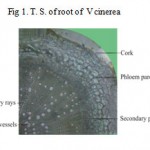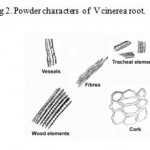How to Cite | Publication History | PlumX Article Matrix
Preliminary Pharmacognostic Evaluations and Phytochemical Studies on Root of Vernonia Cinerea Less.
Rajshekar M. Bhande1*, B. G. Deshapande2, Darshan M Chokeda3 and S. Ramachandra Setty4
1Department of Pharmacology, RRK’s College of Pharmacy, Bidar, Karnataka India.
2Sri Siddharameshwara Ayurvedic College Bidar, Karnataka India.
3Department of Pharmacognosy Sri Siddhalingeshwara College of Pharmacy, Bidar Karnataka India.
4Department of Pharmacology SCS college of Pharmacy, Harapanahalli, Karnataka India.
ABSTRACT: Vernonia cinerea Less. belongs to family Asteraceae and is widely distributed in India. It grows up to 12-75cms in height with cylindrical stem, bears pinkish violet colored flowers. The plant consists of tap root which is used as a folklore medicine in many countries as Antimicrobial, Antidiarrhoeal and Antileprotic. Even though the root of plant has gained scientific importance recently, there is a need for Pharmacognostic standardization. Hence, the present work the root part of the plant was subjected to microscopical and physical evaluation. In the microscopical studies, the different cell structures and powder characters were studied. In the Physical evaluation the Ash value, Extractive value, Loss on drying and reaction of powder with chemical reagents were studied. The various Pharmacognostical constants obtained could help in the development of a suitable monograph for the plant.
KEYWORDS: Vernonia cinerea Less; pharmacognostic; phytochemical; powder analysis
Download this article as:| Copy the following to cite this article: Bhande R. M, Deshapande B. G, Chokeda D. M, Setty S. R. Preliminary Pharmacognostic Evaluations and Phytochemical Studies on Root of Vernonia Cinerea Less. Biosci Biotech Res Asia 2010;7(2) |
| Copy the following to cite this URL: Bhande R. M, Deshapande B. G, Chokeda D. M, Setty S. R. Preliminary Pharmacognostic Evaluations and Phytochemical Studies on Root of Vernonia Cinerea Less. Biosci Biotech Res Asia 2010;7(2). Available from:https://www.biotech-asia.org/?p=9666 |
Introduction
Vernonia cinerea Less. known as purple fleabane in English, Sahadevi in Sanskrit, Garita kammi in Telugu and Sahadevi or Sadodi in local language. The plant is distributed throughout India as a weed on road sides and open places. The plant is branched herb, erect or decumbent growing up to 12-75 cms height, with cylindrical, glabrous, slightly branched stem of
10-17 cms long, 1-8 mm thick. The leaves are simple, alternate, lanceolate, 2.5 cms long and 1.8-3.6 cms broad. The flowers are pinkish violet, in small heads. Fruits are oblong achenes slightly narrowed at the base, clothed with appressed white hairs. Roots are 5-12 cms long, 1-7mm thick, oblique and gradually tapering, bearing few root lets, external surface dirty brown, fracture short. The roots are useful in Diarrhoea, Abdominal pain, Cough, Renal and Vesical calculi. Roots are said to be beneficial in vitiated conditions of Vata, Leucoderma, Inflammation and Intermittent fever.
Literature survey on Vernonia cinerea Less. suggest various therapeutic use of plant reported such as anti-inflammatory(E.O.Iwalwa et.al, 2003), anti-pyretic (Malaya Gupta et.al., 2003), Hyppoglycemic activity(G.Y.Sy et.al., 2005), fungistatic activity (G.N. Krishna et.al., 2003) and Antidiuretic activity ( J.O. Adeboye et.al., 1997)
Materials And Methods
The roots of Vernonia cinerea Less. collected in the month of November from agricultural land in Chillargi, Bidar, Karnataka, India. The plant was authenticated by Prof. B.S.Sajjan, Head, Dept of Botany B.V.B.College , Bidar, Karnataka. A T S of boiled root in Chloral Hydrate was prepared and mounted on glass slide for identification of cellular structures. Powder of dried root was used for the observation of the powder microscopic characters, Ash value, Extractive values, Phytochemical constituents.
Results and Discussion
Transverse section of root (Fig 1)
Mature root shows 4-5 layered cork, consisting of tabular, tangentially elongated, thick walled cells filled with reddish brown contents; secondary cortex consists of white zone of thin walled paranchymatous cells having a few resin ducts, secondary phloem, a narrow zone composed of sieve elements and phloem parenchyma, transversed by phloem rays, xylem well developed, composed of vessels, tricheids, fibers and xylem parenchyma, transverse by 1-5 seriate xylem rays.
 |
Figure 1 T. S. of root of V cinerea.
|
Powder microscopy of root: (fig 2)
4-5 layers of cork cells seen in surface view
Xylem vessels are solitary or 2-4 in groups with reticulate thickening
Fibers are aseptate and pointed
Wood elements are well developed wide vessels with reticulate thickenings
 |
Figure 2: Powder characters of V cinerea root.
|
Behavior of powder with reagents
Behavior of root powder with different reagents was studied to detect the presence of phyto constituents with colour changes under day light by reported method (K. Mukharjee, 2002). The results are shown in table I
Table 1: Behavior of root powder of V. cinerea with reagents.
| Sl.No | Colour/ Precipitate | Constituents |
| 01 | No precipitation | Alkaloid absent |
| 02 | No Change | Steroids absent |
| 03 | Yellowish green | Tannins present |
| 04 | No colour change | Starch absent |
| 05 | Yellow | Flavonoides present |
| 06 | Magneta | Flavonoides present |
| 07 | No Change | Anthraquinone glycosides absent |
| 08 | No Change | Anthraquinone glycosides absent |
| 09 | No colour change | Cardiac glycoside absent |
| 10 | No yellow Ppt | Protein absent |
| 11 | No ppt | Protein absent |
| 12
13 14 |
No Change
White ppt No effervescence |
Carbohydrate absent
Tannins Present Acidic compound absent |
Physico-chemical parameters
The various physico-chemical parameters like Total ash, Acid insoluble ash, Watersoluble ash, Extractive values and loss on drying values of the root powder were done as per IP 2007 and results are tabulated in table II
Table 2: Physico-chemical constants of V. cinerea root .
| Sl.No | Parameters | Value(% w/w) |
| 1 | Loss on drying | 03.83 |
| 2 | Total ash | 04.66 |
| 3
4 5 6
|
Acid insoluble ash
Water soluble ash Water soluble extractive Alcohol soluble extractive |
00.66
02.50 06.33 03.00 |
Preliminary Phytochemical screening
Preliminary Phytochemical screening was carried out by using standard procedure described by Kokate(1986) and Harborne (1998) and results are given in table III
Table 3: Preliminary phytochemical screening of V. cinerea root.
| Sl.No | Phytochemical
Constituents |
Petroleum
Ether Extract |
Chloroform
Extract |
Absolute
Ethanolic Extract |
70% Ethanolic
Extract |
Aqueous Extract |
| 1 | Alkoloids | – | – | – | – | – |
| 2 | Carbohydrates | – | – | – | – | – |
| 3 | Glycosides | – | – | – | – | – |
| 4 | Steroids | + | – | – | – | – |
| 5 | Saponnins | – | – | – | – | – |
| 6 | Flavonoides | – | – | + | + | + |
| 7 | Tannins | – | – | – | + | + |
| 8 | Triterpenoids | – | – | – | – | – |
| 9 | Protein & Amino Acids | – | – | – | – | – |
| 10
11 |
Fixed oil & Fats
Mucilage |
–
– |
–
– |
–
– |
–
– |
–
–
|
Where: + = Present, – = Absent
Conclusion
As there is no pharmacognostical work on record of this traditionally much valued drug, the present work was taken up with a view to lay down standard, which could be useful to detect the authenticity of this medicinally used plant. Macro and microscopical and proximate analysis standards discussed here can be considered as identifying parameters to authenticate the drug.
Acknowledgements
The authors are thankful to Dr K.S.Rao Principal RRK’s College of Pharmacy Bidar, Karnataka for providing the facilities to carry out the work and Dr M. H. Patil Head, dept of Pharmacognosy, Karnataka college of pharmacy, Bidar, for his valuable suggestions and guidance.
The authors are also thankful to prof B.S. Sajjan Head, Dept of Botany, B.V.B. College Bidar for identification and authentification of the plant.
References
- Abeysekera AM, Inhibition of chemiluminescene generated by Zymosan-activated polymorphonuclear leucocytes by phenolic constituents of V.Cinerea, Fitoterapia, 70: 317-319 (1999).
- Adeboye JO, Diuretic and anti-diuretic activity of the leaf extract of V.Cinerea, Phytotherapy Research, 11: 454-456 (1997).
- Adeboye, J.O., Asije, W. diuretic and antidiuretic activity of V.cinerea, Phytotherapy research,2;454-456(1997).
- Adedeji,O., Jewoolao.A, Importance of leaf epidermal characters in the Asteraceae family., Notulae botanical horti agrobotinci cluj-napoca, 36: 7-16 (2008).
- Anonymous, Indian pharmacopoeia, vol ii , 3rd ed., Government of India, ministry of health controller of publications, New Delhi, India, P 74(1985).
- Y. Sy, Ciss.A., Hypoglycemic and antidiabetic activity of acetone extract of V.cinerea leaves in normal glycemic and alloxan induced diabetic rats, Journal of ethnopharmacology, 98: 171-175(2005).
- Gopalsimha K.R., Standardization of Ayurvedic poly herbal formulation Nyagrodhadi churna, Indian journal of traditional knowledge, 64(4): 648-652(2007).
- Gupta D and Dutt AK , Studies on the variation in V.Cinerea less, Bull. Bot.SOC. Bengal, 11(1977).
- Iwalewa E.O., Analgesic, antipyretic, anti inflammatory effects of methanol, chloroform and ether extracts of V.cinerea, Journal of ethnopharmacology,86: 229-234(2003).
- Khandelwal KR, Practical pharmacognosy, 9th ed., Nirali prakashan, pune, India. PP 157-161(2008).
- Kiritkar K R, Basu BD, Indian medicinal plants, vol.I, International book distributors, Dehradun, India., PP 641-643: 98-103(1995).
- Kokate CK , Practical pharmacognosy, 4th ed., Vallabh prakashan, New Delhi, India, PP112-120(1994).
- Krishna GN, Fungistatic sesquiterpene from vernoria arborea. Fitoterapia, 74: 479-482(2003).
- Latha R, Geeta T, Effect of V.Cinerea less flower extract in adjuvant-induced arthritis. Gen. Pharmacol. 31: 601-606(1998).
- Malaya Gupta, Evaluation of anti pyretic potential of V.cinerea extracts in rats, Phytotherapy research, 17: 804-806(2003).
- Malaya Gupta, Mazamder,U.K., antibacterial activity of V.cinerea, Fitoterapia, 74; 148-150(2003).
- Mazumdar UK, Evaluation of anti-inflammatory activity of V.Cinerea extracts in rats, Phytomedicine, 10: 185-188(2003).
- Misra TN, Singh RS, A new triterpenoid froma V.Cinerea, plant med. 59: 458-460.
- Purohit S.S (2003). Hand book of medicinal plant, 1st ed., Agrobios, Indai. PP 447-450(1993).
- Shanta T.R. Pharmacognostical studies of Vatashrungi, 5(3): 388-393(2006).
- Zaluzanin D, A fungistatic sesquiterpene from V.cinerea, Fitoterpia, 74: 479-482(2003).

This work is licensed under a Creative Commons Attribution 4.0 International License.





